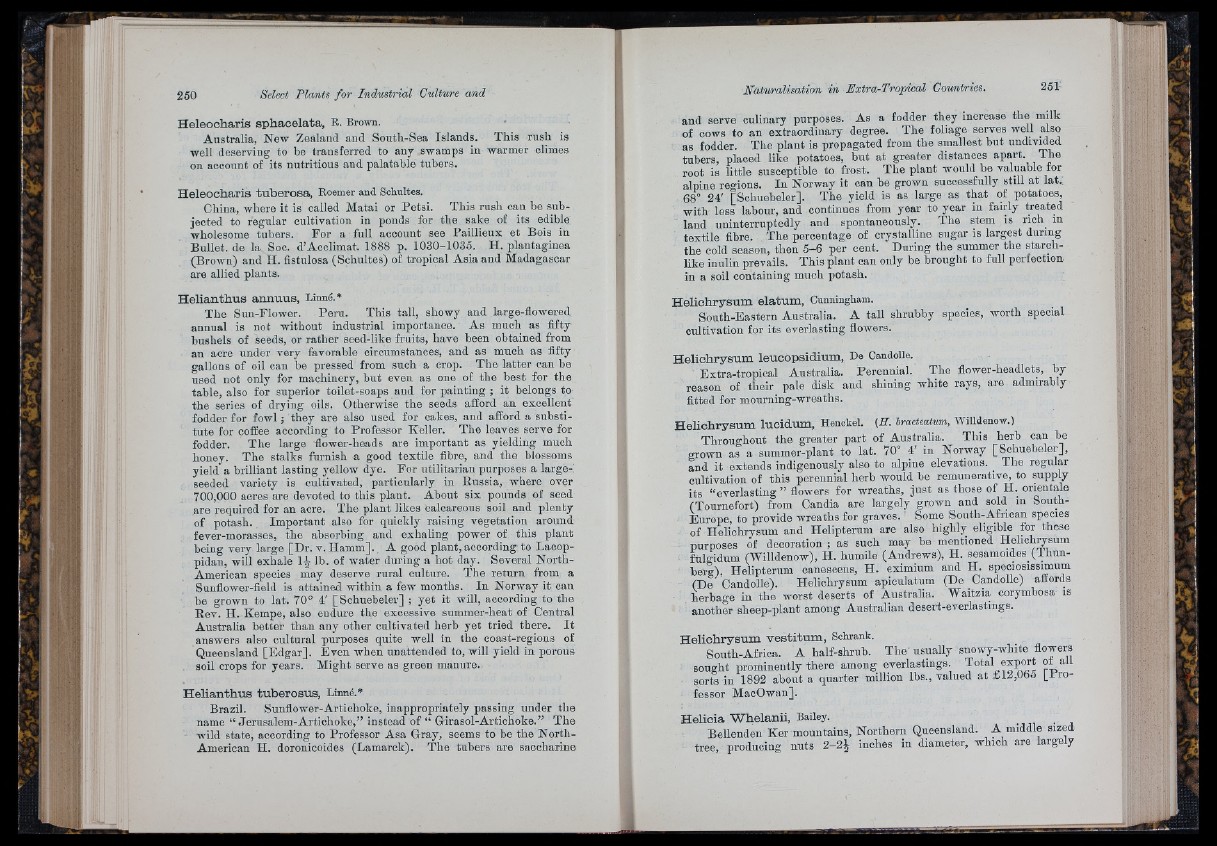
250 Select Plants fo r Industrial Culture and
H e le o c h a ria s p h a c e la ta , R. Brown.
Australia, New Zealand and Soutli-Sea Islands. This rush is
well deserving to be transferred to any swamps in warmer climes
on account of its nutritious and palatable tubers.
H e le o c h a ris tu b e ro s a , Roemer and Schultes.
China, where it is called Matai or Petsi. This rush can he subjected
to regular cultivation in ponds for the sake of its edible
wholesome tubers. For a full account see Paillieux et Bois in
Bullet, de la Soc. d’Acclimat. 1888 p. 1030-1035. H. plantaginea
(Brown) and H. fistulosa (Schultes) of tropical Asia and Madagascar
are allied plants.
H e lia u th u s a u u u u s , Linné.*
The Sun-Flower. Peru. This tall, showy and large-flowered
annual is not without industrial importance. As much as fifty
bushels of seeds, or rather seed-like frnits, have been obtained from
an acre under very favorable circumstances, and as much as fifty
gallons of oil can be pressed from such a crop. The latter can be
used not only for machinery, but even as one of the best for the
table, also for superior toilet-soaps and for painting ; it belongs to
the series of drying oils. Otherwise the seeds afford an excellent
fodder for fowl ; they are also used for cakes, and afford a substitute
for coffee aecording to Professor Keller. The leaves serve for
fodder. The large flower-heads are important as yielding much
honey. The stalks furnish a good textile fibre, and the blossoms
yield a brilliant lasting yellow dye. For utilitarian purposes a large-!
seeded variety is cultivated, particularly in Russia, where over
700,000 acres are devoted to this plant. About six pounds of seed
are required for an acre. The plant likes calcareous soil and plenty
of potash. Important also for quickly raising vegetation around
fever-morasses, the absorbing and exhaling power of this plant
being very large [Dr. v. Hamm]. A good plant, according to Lacop-
pidan, will exhale 1^ lb. of water during a hot day. Several North-
American species may deserve rural culture. The return from a
Sunflower-field is attained within a few months. In Norway it can
be grown to lat. 70° 4' [Schuebeler] ; yet it will, according to the
Rev. H. Kempe, also endure the excessive summer-heat of Central
Australia better than any other cultivated herb yet tried there. I t
answers also cultural purposes quite well in tbe coast-regions of
Queensland [E d g a r]. Even when unattended to, will yield in porous
soil crops for years. Might serve as green manure.
H e lia n th u s tu b e ro s u s , Linné.*
Brazil. Sunflower-Artichoke, inappropriately passing under the
name “ Jerusalem-Artichoke,” instead of “ Girasol-Artiohoke.” The
wild state, according to Professor Asa Gray, seems to be the North-
American H. doronicoides (Lamarck). The tubers are saccharine
Naturalisation in Extra-Tropical Countries. 251
and serve culinary purposes. As a fodder they increase the milk
of cows to an extraordinary degree. The foliage serves well also
as fodder. The plant is propagated from the smallest hut undivided
tubers, placed like potatoes, but a t greater distances apart. The
root is little susceptible to frost. The plant would be valuable for
alpine regions. In Norway it can be grown suooessfully still a t lat.,
68° 24' [Schnebeler]. The yield is as large as th a t of potatoes,
with less labour, and continues from year to year in fairly treated
land uninterruptedly and spontaneously. The stem is rich m
textile fibre. The percentage of crystalline sugar is largest during
the cold season, then 5-6 per cent. During the summer the starch-
like inulin prevails. This plant can only be brought to full perfection
in a soil containing much potash.
H e lic h ry s um e la tum , Cunningham.
South-Eastern Australia. A tall shrubby species, worth special
cultivation for its everlasting flowers.
H e lic h ry s um le u c o p s id ium , De Candolle.
Extra-tropical Australia. Perennial. The flower-headlets, by
reason of their pale disk and shining white rays, are admirably
fitted for mourning-wreaths.
H e lic h ry s um lu c id um , Henckel. (H. hraeteatum, Willdenow.)
Throughout the greater part of Australia. This herb can be
grown as a summer-plant to lat. 70° 4' in Norway [Schuebeler],
and it extends indigenously also to alpine elevations. The regular
cultivation of this perennial herb would he remunerative, to supply
its “ everlasting ” flowers for wreaths, ju s t as those of H. orientala
(Tournefort) from Candia are largely grown and sold, in South-
Europe, to provide wreaths for graves. Some South-African species
of Helichrysum and Helipterum are also highly eligible for these
purposes of decoration ; as such may be mentioned Helichrysum
fulgidum (Willdenow), H. humile (Andrews), H. sesamoides (Thnn-
berg), Helipterum canescens, H. eximium and I I . speciosissimum
(De Candolle). Helichrysum apiculatum (De Candolle) affords
herbage in the worst deserts of Australia. Waitzia, corymbosa is
another sheep-plant among Australian desert-everlastings.
H e lic h ry s um v e s t i tu m , Schrank.
South-Africa. A half-shrub. Tbe usually snowy-white flowers
sought prominently there among everlastings To^al export of all
sorts in 1892 about a quarter million lbs., valued a t £12,065 [P ro fessor
MacOwan].
H e lic ia W h e la n ii, Bailey. . , • »
Bellenden Ker mountains. Northern Queensland. A middle sized
tree, producing nuts 2 -2 ^ inches in diameter, which are largely
y '
J
Ì-' . 1■'i-' ' 'jt
IE -
: ' Ì
i'
ifr-'h '1f; ’ .